 Recently, we raised the question as to whether or not 90 percent of patents which are being challenged at the Patent Trial and Appeal Board (PTAB) are being found defective once trial proceedings have concluded. There are those individuals who vigorously defend the workings of the PTAB as an administrative body, pointing towards statistics on denial of institution or trial settlements in order to deflect any viewpoint that the PTAB is mowing down patents at an unusually high rate. There is also a pervasive viewpoint that the patents being challenged are weak patents that deserve to be declared invalid.
Recently, we raised the question as to whether or not 90 percent of patents which are being challenged at the Patent Trial and Appeal Board (PTAB) are being found defective once trial proceedings have concluded. There are those individuals who vigorously defend the workings of the PTAB as an administrative body, pointing towards statistics on denial of institution or trial settlements in order to deflect any viewpoint that the PTAB is mowing down patents at an unusually high rate. There is also a pervasive viewpoint that the patents being challenged are weak patents that deserve to be declared invalid.
Nevada-based tech licensing company VirnetX Holding Corporation (NYSEMKT:VHC) is a good case in point when trying to ascertain whether the PTAB is doing a virtuous job of cleaning up the U.S. patent system and invalidating weak patents. VirnetX has brought eight patent infringement proceedings to U.S. district court, specifically the Eastern District of Texas. Three suits have been filed against Microsoft Corporation (NASDAQ:MSFT), four against Apple Inc. (NASDAQ:AAPL) and one suit has been filed against Canadian telecom firm Mitel Networks Corporation (NASDAQ:MITL). The cases have been filed between February 2007 and August 2013; three of the actions filed against Apple remain open.
 Data pulled from Lex Machina shows that VirnetX has been fairly successful at asserting its intellectual property in district court. Case resolutions show that VirnetX has achieved a claimant win in one case and four other cases have terminated with likely settlements; one of those settlements was a plaintiff voluntary dismissal in one of the Apple cases, which was filed after the patent at issue was added to one of the other district court proceedings against Apple. These cases ended up being very valuable to VirnetX, at least
Data pulled from Lex Machina shows that VirnetX has been fairly successful at asserting its intellectual property in district court. Case resolutions show that VirnetX has achieved a claimant win in one case and four other cases have terminated with likely settlements; one of those settlements was a plaintiff voluntary dismissal in one of the Apple cases, which was filed after the patent at issue was added to one of the other district court proceedings against Apple. These cases ended up being very valuable to VirnetX, at least 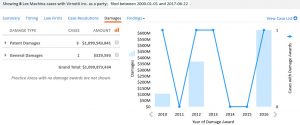 initially.
initially.
VirnetX has been awarded nearly $1.1 billion total damages from the cases thus far. The jury verdict form in one of the Microsoft cases shows that VirnetX proved willful infringement of two of its patents, earning reasonable royalties in an amount reaching $105.75 million. A jury verdict entered in one of the Apple cases shows that 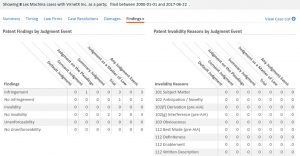 VirnetX also proved willful infringement of the asserted patents in that case, entering a reasonable royalty award of $625.33 million for infringement posed by Apple’s FaceTime and iMessage services as well as virtual private network (VPN) features. Analysis shows that all of the VirnetX patents asserted in district court survived every single challenge of invalidity; not a single patent claim was declared invalid under Section 101, Section 102 or Section 103 statutes and findings of no invalidity are also reflected in the Microsoft jury verdicts.
VirnetX also proved willful infringement of the asserted patents in that case, entering a reasonable royalty award of $625.33 million for infringement posed by Apple’s FaceTime and iMessage services as well as virtual private network (VPN) features. Analysis shows that all of the VirnetX patents asserted in district court survived every single challenge of invalidity; not a single patent claim was declared invalid under Section 101, Section 102 or Section 103 statutes and findings of no invalidity are also reflected in the Microsoft jury verdicts.
Obviously, the patents asserted by VirnetX were considered to be both valid and of great value, at least in a federal district court. In the Apple case, the jury found infringement of the following patents:
- U.S. Patent No. 6502135, titled Agile Network Protocol for Secure Communications with Assured System Availability. It claims a method of transparently creating a VPN between a client computer and a target computer in a way that overcomes security issues in distributed systems which aren’t solved by traditional firewalls.
- U.S. Patent No. 7418504, titled Agile Network Protocol for Secure Communications Using Secure Domain Names. It protects a system for providing a domain name service for establishing a secure communication link, the system configured for storing a plurality of domain names and corresponding network addresses, receiving queries for network addresses and indicating whether the domain name service system supports secure communication links.
- U.S. Patent No. 7490151, titled Establishment of a Secure Communication Link Based on a Domain Name Service (DNS) Request. It claims a data processing device comprising memory storing a module for intercepting DNS requests sent by a client and determining whether those intercepted requests correspond to a secure server.
- U.S. Patent No. 7921211, same title as the ‘504 patent. It protects a system for providing a domain name service configured and arranged to be connected to a communication network in a way that allows message payloads to be encrypted into tunneled agile routing protocol (TARP) packets which can only be unlocked using a session key.
Not only have VirnetX’s patents earned them large awards of reasonable royalties at the district court level, they’ve also survived patent validity challenges at the U.S. Court of Appeals for the Federal Circuit. Although the Federal Circuit vacated and remanded a district court damages award for VirnetX in September 2014 in VirnetX, Inc. v. Cisco Systems, Inc., an action arising out of one of the Apple cases, it “affirm[ed] the jury’s findings that none of the asserted claims are invalid and that many of the asserted claims of the ‘135 and ‘151 patents are infringed by Apple’s VPN On Demand product.”
So obviously the patent claims VirnetX has used to pursue infringers such as Apple and Microsoft are not the weak patents that opponents of the patent system claim are the scourge of the system. Well — not so fast! Just because an Article III federal district court confirms the validity of a patent doesn’t mean anything anymore. Indeed, federal courts have become subordinate to the PTAB, which is as ridiculous as it sounds but sadly true. A patent is not valid until an Article I executive tribunal says so, and absolutely no deference is paid to Article III judges of the United States federal courts.
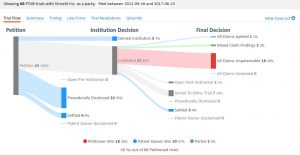 Indeed, from June 2013 through November 2016, VirnetX faced a barrage of 68 inter partes review (IPR) challenges at the PTAB. Apple is listed as a petitioner on 42 of those IPR petitions. Other parties filing petitions include Microsoft, RPX Corporation, Black Swamp IP, LLC, and The Mangrove Partners Master Fund, Ltd. Only one of those petitions resulted in a final written decision finding all claims patentable. 18 final written decisions found that all claims were unpatentable.
Indeed, from June 2013 through November 2016, VirnetX faced a barrage of 68 inter partes review (IPR) challenges at the PTAB. Apple is listed as a petitioner on 42 of those IPR petitions. Other parties filing petitions include Microsoft, RPX Corporation, Black Swamp IP, LLC, and The Mangrove Partners Master Fund, Ltd. Only one of those petitions resulted in a final written decision finding all claims patentable. 18 final written decisions found that all claims were unpatentable.
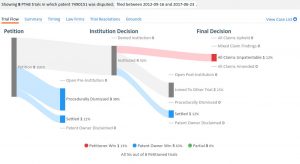 It appears that the patents that have been adjudicated to be worth hundreds of millions of dollars in district court were the ones targeted most heavily at the PTAB. The ‘151 patent, the validity of which was specifically affirmed by the Federal Circuit, was targeted by 8 IPR petitions at the PTAB. Two petitions resulted in settlements, one of which was post-institution, three others were procedurally dismissed prior to institution and one other petition was
It appears that the patents that have been adjudicated to be worth hundreds of millions of dollars in district court were the ones targeted most heavily at the PTAB. The ‘151 patent, the validity of which was specifically affirmed by the Federal Circuit, was targeted by 8 IPR petitions at the PTAB. Two petitions resulted in settlements, one of which was post-institution, three others were procedurally dismissed prior to institution and one other petition was 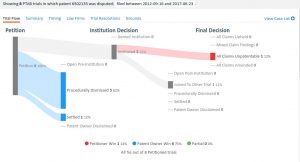 instituted, leading to a final written decision of all claims unpatentable. This invalidated claims 1, 2, 6 through 8 and 12 through 14 of the ‘151 patent as anticipated by a combination of prior art. Similar fates befell the ‘135 patent, the other patent whose validity was affirmed by the Fed. Cir., as well as the ‘504 and the ‘211 patents.
instituted, leading to a final written decision of all claims unpatentable. This invalidated claims 1, 2, 6 through 8 and 12 through 14 of the ‘151 patent as anticipated by a combination of prior art. Similar fates befell the ‘135 patent, the other patent whose validity was affirmed by the Fed. Cir., as well as the ‘504 and the ‘211 patents.
 Amazingly, these PTAB decisions seem to have completely changed the Federal Circuits stance on the patent eligibility of the subject matter in the VirnetX patents. In one decision handed down by the Federal Circuit in December 2016, the court upheld findings of invalidity at PTAB on yet another VirnetX patent
Amazingly, these PTAB decisions seem to have completely changed the Federal Circuits stance on the patent eligibility of the subject matter in the VirnetX patents. In one decision handed down by the Federal Circuit in December 2016, the court upheld findings of invalidity at PTAB on yet another VirnetX patent 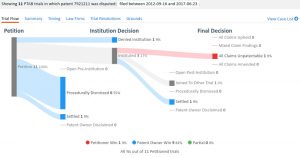 that had been asserted against Apple. The same day of that decision, VirnetX released a press release noting that three Federal Circuit decisions upheld PTAB invalidity findings. One could be forgiven for thinking that the Federal Circuit was acting somewhat capriciously in determining whether or not VirnetX’s patents cover eligible subject matter, given the fact that the court has affirmed lower court decisions that reached wildly different conclusions on validity.
that had been asserted against Apple. The same day of that decision, VirnetX released a press release noting that three Federal Circuit decisions upheld PTAB invalidity findings. One could be forgiven for thinking that the Federal Circuit was acting somewhat capriciously in determining whether or not VirnetX’s patents cover eligible subject matter, given the fact that the court has affirmed lower court decisions that reached wildly different conclusions on validity.
There’s been a great deal of discussion in recent years on whether the PTAB is a death squad for commercially viable patents. At least in the case of VirnetX, this definitely appears to be the case. The “patent as piñata” metaphor also seems fitting in this case. It’s as if Apple, Microsoft, RPX and others are children sitting at a birthday party, each of them getting a turn to take a crack at the VirnetX piñata (Apple getting the most cracks because, let’s remember, this is Apple’s party at the end of the day). Those patents which were so valid and valuable in district court proceedings are simply mounds of papier-mâché at the PTAB, cracking every time with enough swings of the bat.
The PTAB has always been touted as an alternative venue to U.S. district courts, which would lower the costs of fighting patent infringement cases. Increasingly, however, the PTAB does not lower the cost of patent infringement litigation but instead increases the cost in many situations, such as here where these patents had already thoroughly been litigated and even confirmed valid all the way up to the Federal Circuit.
The PTAB gives efficient infringers a great alternative, which can be used to extricate themselves from jury verdicts awarding hundreds of millions of dollars in reasonable royalties. Of course, the inverse is true for VirnetX, which had to deal with the costs of almost 70 PTAB proceedings sprung from 8 district court cases and saw incredibly valuable and previously confirmed valid property rights ripped away.
It’s clear that the PTAB is far more useful for massive entities who are found to have willfully infringed valid patents and highly detrimental to firms who are working to commercialize the inventions of individuals and small entities.

![[IPWatchdog Logo]](https://ipwatchdog.com/wp-content/themes/IPWatchdog%20-%202023/assets/images/temp/logo-small@2x.png)


![[Advertisement]](https://ipwatchdog.com/wp-content/uploads/2024/04/UnitedLex-May-2-2024-sidebar-700x500-1.jpg)
![[Advertisement]](https://ipwatchdog.com/wp-content/uploads/2024/04/Artificial-Intelligence-2024-REPLAY-sidebar-700x500-corrected.jpg)
![[Advertisement]](https://ipwatchdog.com/wp-content/uploads/2024/04/Patent-Litigation-Masters-2024-sidebar-700x500-1.jpg)

![[Advertisement]](https://ipwatchdog.com/wp-content/uploads/2021/12/WEBINAR-336-x-280-px.png)
![[Advertisement]](https://ipwatchdog.com/wp-content/uploads/2021/12/2021-Patent-Practice-on-Demand-recorded-Feb-2021-336-x-280.jpg)
![[Advertisement]](https://ipwatchdog.com/wp-content/uploads/2021/12/Ad-4-The-Invent-Patent-System™.png)






Join the Discussion
25 comments so far.
Mark Sandstrom
June 29, 2017 11:14 am..finishing my paragraph above..
Making patent rights economically enforceable — and respected, like other property rights — again … is necessary for there to be a business case for investing in R&D and in US-led market introductions of new technologies, as well as for the much-needed return of the classical hi-tech venture capital model, with investments again available for startups that will pioneer both their technologies and markets.
Note that the current US-based core tech titans such as Apple, Cisco, HP, Intel, MSFT, Qualcomm, Xilinx etc. did not have much of market traction or revenue when they raised their startup capital; however, in the present investment environment, investments cannot be raised for modern-day equal innovations of microprocessor — a true tech innovation will open a new (and value-adding) market front, rather than serve markets based on previous tech generations, and as such, the pioneering company’s launch will depend on availability of pre-revenue investments, attracted by actual enforceability of the pioneering company’s intellectual property assets.
Mark Sandstrom
June 29, 2017 10:45 amAn anecdote: my founder-funded tech ventures have developed patented technologies that, per 3rd party legal research/opinions, are now part of massively deployed standard/open source technologies. Based on 3rd party data and analyses, the unlicensed use of the patent claims allows the large tech corporations to reach their revenues with several billions of dollars in upfront capacity costs savings, along with proportional operating cost savings, due to the capacity efficiency enabled by the patented inventions. All the while the innovation pioneering patent holding companies lack the (access to) funds to offer commercial services based on their technology innovations. Trying to raise capital by enforcing the patent rights for reasonable royalties is also cost-prohibitive for most market entrant level patent holders.
The status quo — that it will take $Ms and several years to get court assessed royalties, with even the serial AIA-IPR defense costs potentially lethal for founder funded tech companies — means that there will be an anti-innovation, anti-transformation class-society in business.
Simply, if you just happen to lack access to at least $10Ms, your intellectual property rights, even if, at the level of “no less than reasonable royalties” per statutes, worth $Bs, will remain meaningless — with the consequence that technology innovations will make it to production use only at the pace and manner dictated by the incumbent corporations, often enjoying the benefits of large public sector contracts etc. and/or having otherwise having an entrenched role in our society.
In the case of the mentioned tech ventures, the delay from prototyping by the patent holding company to the (unlicensed) deployment by the established corporations has been in the range of 5 to 15 years.
This is BIGCORPORATEAMERICA inaction, where the R&D-to-production-use pace is lagging even the state-run command-economies.
Making patent rights economically enforceable — and respected, like other property rights — again, e.g., by permitting invalidation of patent claims only based on actually anticipating 102 prior art, and moving the (inherently relative) considerations of level of obviousness to where they naturally belong – to determination of the level of reasonable royalties; naturally the true contribution (i.e. royalty rate) of a patented invention to value of an infringing product/service should be dependent on the incremental value-add of the given patent claim beyond the non-creative combinations of prior art teachings.
Joachim Martillo
June 28, 2017 01:20 pmThe PTAB is not the only problem.
I just put up a short article on the June 23, 2017 CAFC decision in Nantkwest v Matal (2016-1794).
The hyperlink is Rigging the Patent System in Favor of Large Incumbent Corporations.
angry dude
June 27, 2017 11:30 pmEric Berend @20
Well said, dude !
but, screw AlphaGoog
I now only use protonmail for all of my email communications and keep all my files on my own portable hard drive (backed up to my own PC and not to the google cloud)
Trade secrets rule !
Welcome to USA, year 2017…
Patent Investor
June 27, 2017 07:32 pmAnd one last thing about the VirnetX patents at the PTAB. There seems to be no prior art which will not invalidate the patents, any patent, every patent. The trio of Easthom, Tierney, and Siu would most likely find a VirnetX patent obvious in light of Moe, Curly, and Schemp Fine. Do you think Apple wants them buried???
Eric Berend
June 27, 2017 01:09 pmAs U.S. inventors recoil even further in horror at such derogation before the law not practiced against any other class of individuals and entities in the entire American society, this now macabre IP pirates’ parade continues its grotesque mockery of even a mere iota of a pretense of actual due process.
The avarice of an already absurdly powerful and wealthy ‘tech elite’ to control ever more IP resources ad infinitum, has now advanced to a state of outright gluttony; where no degree of further empowerment can sate the dragon. ‘Move fast and break things!’ – break *everything*. Their rabid poster child – for this truly is wantonly juvenile behavior – is Travis Kalanick. SiliCON Valley is chock full of the Travis Kalanicks of the world, completely immoral as to their unprincipled motivation and literally feral attitudes.
They respect not equity, liberty, competition, reason, jurisprudence, professionalism; nor, any other tenets and beliefs of a well-established civilized society – and certainly not any notion of justice, fairness nor conscience. This a ‘New World Order’ hegemony of technocrats, bid large to ensnare the very fabric of human life in a terrible panopticon of mammoth proportions.
Here, there is an objective basis to call it evil. This, an oligarchy of bitterly ruthless, almost alien determination behind its populist demeanor, harms all others in our societies in general, with benefits only to itself. Harm is continually perpetrated on the largest scale, driven by mere monstrous ego and a belief in its supreme privilege, surfeit with the bounty of many ill-gotten successes. AlphaGoog is their leader, the dark crown prince of technocratic tyranny in a Brave New World being made increasingly inhuman by their evil exploits.
Cue the magic carpet ride, kiddies; we’ve been yanked down beyond the event horizon, in the ineluctable descent into the societal equivalent of the gravitic singularity known as a black hole.
Patent Investor
June 26, 2017 03:16 pmAgreed Paul Morgan. It is all there in the IPR files for RPX, not sure why more has not been done.
Paul F. Morgan
June 26, 2017 01:48 pmIf an IPR Petitioner can be shown to have made a false representation as to the real party in interest or its privies, and doing so avoids a statutory time bar, the sanctions should be more than just dismissal of the IPR. There should also be disciplinary proceedings against anyone involved.
2L IP Student
June 26, 2017 11:24 amAs a rising 2L law student currently working in an IP group, I was wondering how this would even be possible?
How can an Article I tribunal’s decision be appealed to an Article III court (CAFC) with binding judgment, but then a decision by the same Article III court be re-heard essentially by an Article I tribunal with no deference?
It seems that the problem above only creates 2 bites at the apple for efficient infringers, but no sense of resolution for patent owners.
Anon
June 26, 2017 10:36 amPardon my missed closing of the “Bold” tag….
Anon
June 26, 2017 10:12 amCurious,
Absolutely correct: there is no such thing as a strong patent without meaningful enforcement.
As I have said previously, if people want to crow about patents being granted as some “great thing,” move to a pure registration system at fractions of pennies on the dollar.
The Office currently has a several Billion dollar budget entirely paid by fees on innovators. A top-notch refererence and catalogue system could be had and maintained for perhaps a million dollars or so a year.
IF (and I would say it is indeed a colorable argument) – IF we (the Royal We) are going to depend on post-grant band-aids anyway, then it only makes sense (and tons of cents) to scrap the current system that takes Billions from innovators.
I would be perfectly willing to consider sacrificing the level of presumption of validity if that were on the table.
Of course, my first preference – and not by just a small margin – is for examination to be improved and the protections afforded property be fully recognized by all three branches of the government.
Curious
June 26, 2017 09:50 amLet me add just one other observation. For sake of argument, let’s assume that instead of being owned by a company (VirnetX) with a current market cap (as of today) of approximately $300M, the patents at issue here were owned by a small-entity that could barely scrape together $500K. Does anybody think that this small-entity would have been able to even achieve a tenth of what VirnetX accomplished?
Had a small-entity owned these patents, Apple would have squashed them a long time ago and declared victory. However, even a well-capitalized company such as VirnetX is being swamped by the patent death squads at the PTAB.
I keep writing but it is worth repeating — the current patent system is rigged towards (i) patent infringers and/or (ii) the rich. If you are a patent owner and don’t have a lot of money, the USPTO will extract a good amount of your time and money, but eventually you’ll have a decent chance of obtaining a patent. However, you have no hope in actually using your patent to prevent competitors from using your technology and/or be compensated by those who would profit from your technology.
The patent system is broken — plain and simple. The anti-patent people keep crowing about the record number of patents being issued by the USPTO as evidence of a strong patent system. However, that record number of patents aren’t worth the paper they are printed on if they cannot be enforced.
Anon2
June 26, 2017 09:39 amGreat article.
Persuasive, based on evidence, and very effective. Exactly what is needed to turn the tide.
Patent Wizard
June 26, 2017 03:04 amThe upcoming Oil States case at SCOTUS has to result (I say “has to” in order to restore some sanity to the USA’s best-in-the-world innovation entrepreneurs) with SCOTUS invalidating the ability of PTAB to unilaterally revoke property (patent) rights. Without a favorable decision, the USA will lose its importance as the eye of the technology hurricane currently enveloping the planet. Now, people of all stripes gravitate toward the USA, often to capitalize on their ideas and to find backers for their ground-breaking work. Without the ability to protect their work from thieves in the industry that they wish to improve….why bother? While some innovators may be altruistic and not seek the $millions or $billions they are entitled to, most are desirous of the rewards previously offered to them by the USA patent protection laws and processes. But, with the PTAB running amok, these dreams are turning into nightmares.
SCOTUS has a job to do and Oil States is their vehicle to get it done.
Tesia Thomas
June 25, 2017 05:58 pmPTAB allows for third party standing up to 9 months after patent grant or anytime during post grant procedures whichever is later.
Of course this sucks.
But, the whole law doesn’t require someone be fighting for their own interests.
Standing only matters if the IPR is in response to being accused of infringement of a post-AIA patent after all deadlines are passed.
In the end, Apple could just pay someone else to infringe and then get them to file IPRs. If the patents are invalidated then who cares that they induced infringement when they’re really trying to get out of paying out for direct infringement?
https://ipwatchdog.com/2015/05/27/good-faith-belief-of-patent-invalidity-is-no-defense-to-induced-infringement/id=58126/
Obviously these companies are willing to go to any lengths to invalidate valuable IP and they also apparently wrote the laws.
Bluejay
June 25, 2017 05:22 pmThe fact that an LLC that is a stranger to a patent has standing to file an IPR is astounding to me. Kyle Bass apparently is doing this to pharma companies he is shorting. Not the real party in interest and with no standing.
Not to stretch the analogy too far, but it is reminds me of Charlie Munger’s story about the old women who would take out life insurance policies on homeless men, name themselves as beneficiaries and then murder the guys to collect the insurance. Munger is a lawyer, so was his dad and his grandfather was a federal judge in Nebraska.
Impressive comment by patent investor above.
Night Writer
June 25, 2017 04:37 pm@5 Patent investor: thanks for telling us about this.
It is the no standing requirement that is the problem.
@3 Inventor Rights: what we are seeing in trenches (where I live in this battle) is big companies starting to re-think filing patent applications. They are starting to cut back and thinking that trade secrets or public disclosure is the way to go. We haven’t reached a tipping point yet, but we are close. Take out foreign filings and normalize the patent filings for the number of people and money generated by technology and patent filings are way down over the last 20 years (Mark Lemley argues the opposite without even normalizing for foreign filings. Mark Lemley is a highly unethical person that is a disgrace to this country.)
Tesia Thomas
June 25, 2017 04:29 pm@Patent Investor:
All because of no time bars for filing IPR for pre-AIA patents.
This makes me sick to my stomach.
It has to be illegal somehow.
IPR, especially in the scenario you mention, should violate Antitrust Laws.
Patent Investor
June 25, 2017 04:07 pmLet’s delve a little deeper into Apple’s involvement in these IPR filings. Apple, having had the unfortunate timing of being sued for infringing these patents over a year before the AIA was passed, was never in a position to be the lead petitioner when it came to the patents in suit. However, being the early days of IPRs, Apple filed multiple petitions against the patents in suit in hopes of arguing their way into proper standing. All of which cost VirnetX the cash to defend.
As it seemed obvious that Apple’s attempts to initiate IPRs against the patents in suit were doomed to fail, a newly created LLC (Eastern Shore Capital) created it’s own LLC (New Bay Capital) and filed a series of IPR petitions against, not just the patents in suit but, the claims in suit.
When VirnetX filed for discovery into the Real Parties of Interest, New Bay sent a settlement letter (basically extortion demands to drop the IPRs) and when VirnetX was not interested in playing ball, New Bay dropped their IPRs.
Eight days after the New Bay IPRs were denied at the PTAB, RPX Corp. filed petitions against the four patents in suit. Amazingly enough all the intelligent and technologically capable people at RPX somehow allowed a traceable amount of metadata to cling to several .pdf files exchanged between various parties and this time discovery was allowed into the RPIs. As it turns out RPX was nothing more than a beard behind which Apple was hiding to once again get another bite at the patents in suit. The PTAB panel terminated all seven RPIs filed by RPX.
Almost one year later, as the trial results are still languishing in the tortoise like Federal Court system, along comes Mangrove Capital and two new IPRs. Strangely enough, these IPRs were against the two patents that Apple was found to have infringed by the CAFC opinion ( the ‘135 and the ‘151 and actually just the claims in suit). VirnetX showed to the PTAB panel the obvious connections between Mangrove Capital and RPX (the EXACT SAME PTAB PANEL that had found RPI issues with Apple and RPX), but the panel FOUND NO NEED FOR ADDITIONAL DISCOVERY and told VirnetX to address it in their response to the institution decision (which I believe violates the PTAB’s mandate to address the subject at institution).
And finally, to complete the saga to date, after Apple was once again found to infringe all four patents in suit (and this time by both legacy and current products) here comes Black Swamp IP, LLC out of nowhere to file IPRs against the other two patents in suit not prosecuted by the Mangrove IPRs (the ‘504 and ‘211 and yes, only the claims in suit).
All of this is just as I recall and may be subject to an error or two, any non-factual observations are strictly my own.
Tesia Thomas
June 25, 2017 03:41 pmI agree with @Bluejay. This case should be cited.
This doesn’t make any sense.
If a U.S. patent really is a pinata then it should be a cheap pinata.
I wonder if any of these companies have patents in other countries that they can assert against U.S. entities in those non-U.S. countries.
Isn’t software a global tech no matter what? Barring firewalls.
Most people have a computer and internet connection. So, wouldn’t Apple be using VirnetX’s patents in most other countries?
Invention Rights
June 25, 2017 03:09 pmWhen was the last time a patent owner collected an award? Patents are not enforceable anymore. VirnetX market cap is a fraction of the $1.1B they have “won”, which means they didn’t truly win. Jury verdicts are meaningless. Patent rights are an illusion.
Night Writer
June 25, 2017 02:46 pmGreat article. Some patent judge who is beholden to the Director for their job can just trash any patent they feel like. And these patent judges were selected for being anti-patent.
Bluejay
June 25, 2017 11:46 amGreat article and all true.
This article should be cited in the Oil States brief or by an amicus. SCOTUS must know of this case and how an Executive agency is destroying property rights which the constitution mandates that only federal judges can adjudicate.
One addendum. A jury rendered a $392m verdict against Apple in September 2016. Nine months later, the trial judge still has not published his final judgment in Apple 3. A baby could be conceived and born in the time it has taken Judge Schroeder to decide a now simple case.
Steven
June 25, 2017 11:34 amWell said.
Bemused
June 25, 2017 11:02 amIs there any other patent system in the world that has this kind of post-grant review process with these invalidation percentages? I haven’t looked into it but I seriously doubt it. And yet clowns like Issa, et al continue to push the patent troll narrative seeking still more so-called patent reform. This year the US patent system was ranked 10th in the world tied with Hungary. Can’t wait to see where we’ll be next year in the world patent regimes tables: no doubt ranked somewhere between Afghanistan and Swaziland (and falling).